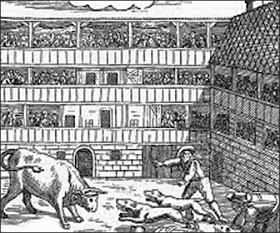Just because a sport is popular, is no guarantee of good
taste and when it comes to entertainment what appeals to one person can be
repulsive to another. This is certainly true of the 18th century
craze for animal baiting, which from the distance of the modern day most
right-minded people find disgusting.
Cocks were pitched against each
other because of their natural aggression to other males and James Boswell
noted in 1762 after attending a fight how the birds fought with ‘amazing bitterness and resolution’ to
the end. It took until 1835 for
cock-fighting to be banned but the legislation did not have sufficient ‘teeth’
and amazingly the activity continued in a widespread manner until the 1911
Protection of Animals Act made it illegal to prepare a place for cock-fighting.
The bear was another animal used
for baiting and the ‘sport’s’ fans included King Henry VIII, who had a
special bear pit constructed at Whitehall, as well as Queen Elizabeth I. Tudor
attitudes were very different to the modern day when such cruelty is to be
abhorred, indeed Elizabeth over-ruled Parliament when they tried to stop
bear-baiting on Sundays. Elizabeth’s court favourite, Robert
Dudley, Earl of Leceister, regularly hosted bear baitings, one of which is
described below
by Robert Laneham (1575).
 |
| The distressing 'sport' of bear-baiting |
“Thursday, the fourteenth of July, and the
sixth day of her Majesty’s coming, a great sort of bandogs [mastiff] were
then tied in the outer court and thirteen bears in the inner . . . It was a
sport very pleasant, of these beasts, to see the bear with his pink eyes
leering after his enemies approach, the nimbleness and wayt [wait] of the dog to take his advantage, and the
force and experience of the bear again to avoid the assaults. If he were bitten
in one place, how he would pinch in another to get free, that if he were taken
once, then what shift, with biting, with clawing, with roaring, tossing and
tumbling, he would work to wind himself free from them. And when he was loose,
to shake his ears twice or thrice with the blood and the slather about his physiognomy,
was a matter of goodly relief.”
 |
| These 'gentlemen' are watching badger-baiting |
Incredibly,
this cruel activity only died out, in the 18th century, because
bears which were extinct in Britain, also became rare in Europe and therefore
too costly to import.
Another example is bull-baiting. The
bull was tied to a stake on a tether with a 30 foot radius. The idea of the
‘sport’ was for dogs to immobilize the bull. This was part justified on the
rather thin belief that baiting improved bull meat. Indeed, some towns had
bye-laws stating meat from a bull could not be sold unless the animal first
been baited.
 |
| Rat-baiting |
In the
early 19th century social attitudes began to change, but when the
topic of banning bull-baiting was debated in parliament, the future prime
minister Sir William Pulteney argued that:
‘The amusement
inspired courage and produced a nobleness of sentiment and elevation of mind.’
An example of the wide spread
nature of bull-baiting is found in the name of the main commercial area of the city
of Birmingham, UK – which is called the Bull Ring (or Bullring in the modern
day). The ‘ring’ refers to the hoop of iron to which the bull was tethered for
baiting prior to slaughter. [It is perhaps testament to the British love of
tradition that the 21st century contraction of Bull Ring to Bullring
caused anger amongst the locals who looked on the former as the true, historic
spelling.]
 |
| A modern nod to the origins of Birmingham Bullring |
And finally…the dogs used in the
vile activity of bull baiting were bred for purpose and when bull-baiting was
banned, the numbers of these dogs fell dramatically. Around 1865 dog fanciers
worried about the breed going into decline set about breeding the remaining
animals together so as to preserve the breed. It is from these dogs that the
British bulldog was derived – that national symbol of determination and
fighting spirit!



No comments:
Post a Comment
Due to the amount of SPAM I have been forced to moderate comments. If you are a spammer - please go away! You comment will not be posted and you are wasting your own time.
G